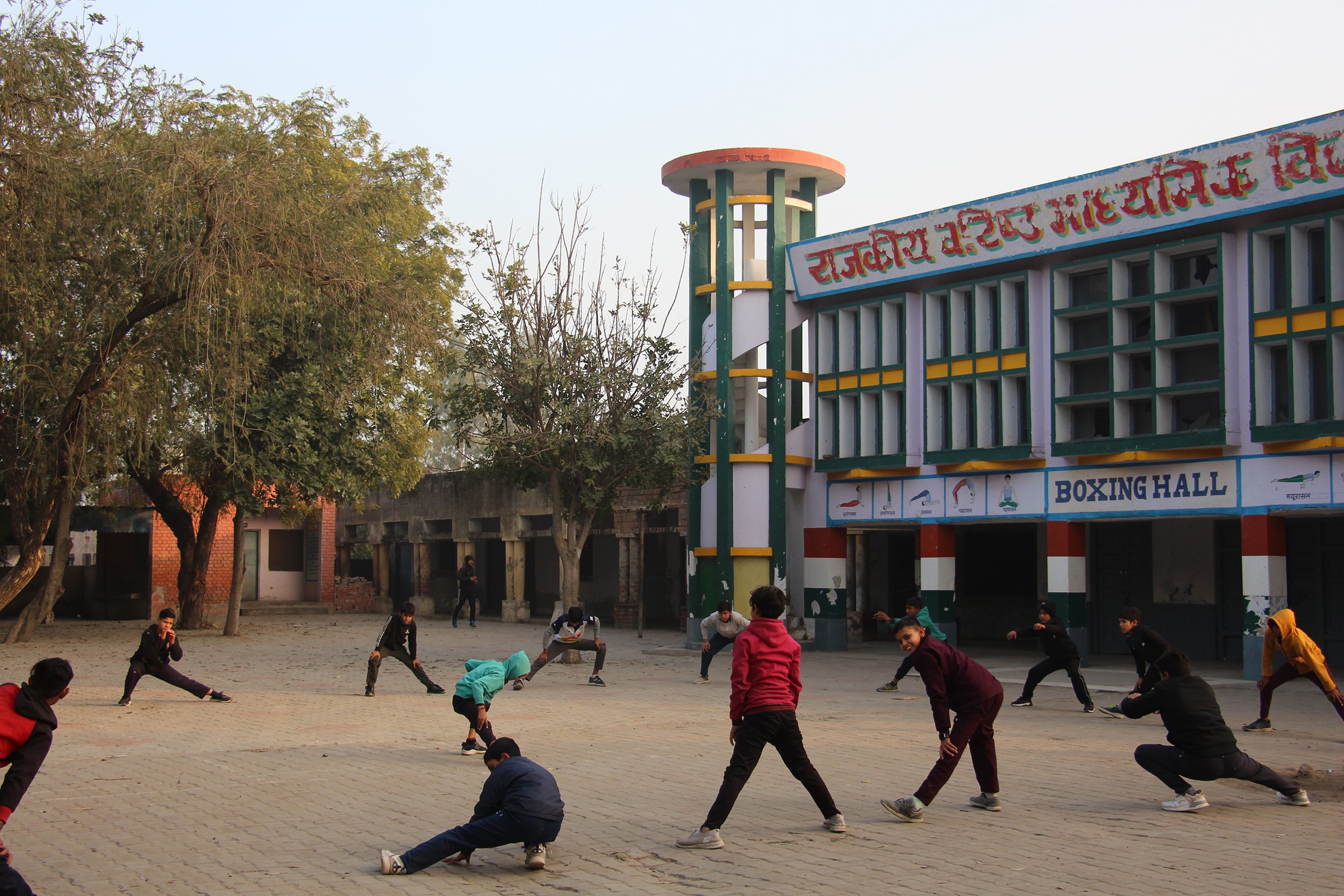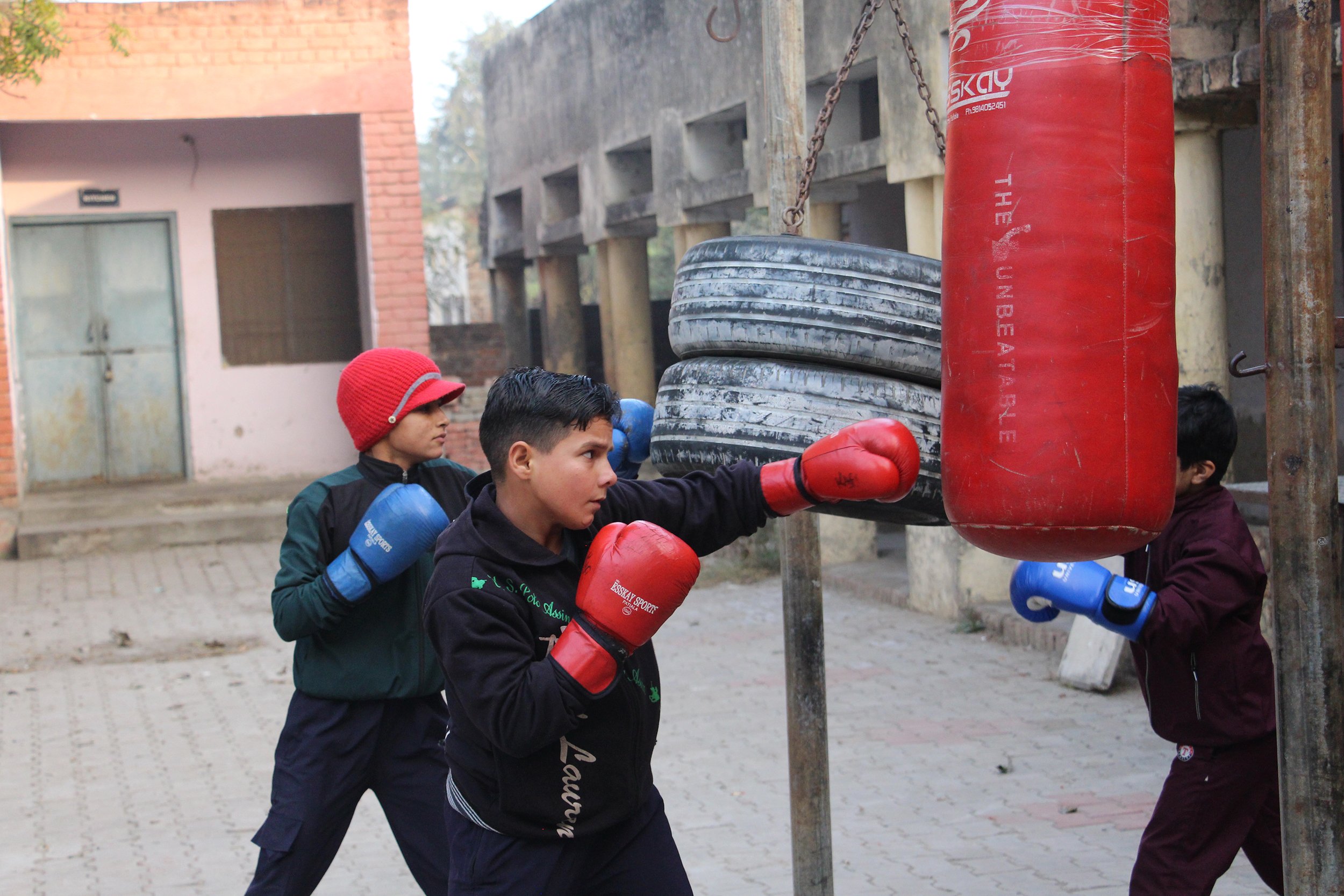Punching through poverty
Through a government program, a 15-year-old girl boxes to become a champion and fights to earn more money for her family.
By Soraya Keiser
Fifteen students warm up before sunrise with little visibility through the fog for an early morning boxing practice. Because of a power cut, they run through drills and exercises by the light of a phone flashlight and the rising sun. | Photo by Luca Lombardi
At 6 a.m. Harsola sleeps, the fog a blanket across the town. Alongside a few stray dogs and cows, teen boxers make their way to school four hours before classes begin. Some ride bikes or are dropped off by mothers wrapped in scarves against the 35-degree cold. Anjali, 15, and her brother walk themselves along the main road and through the gate of the school — barely visible to anyone unless they are less than 10 feet away. Students arrive out of the mist, like singers stepping through a fog machine onto a stage.
As the child of a dairy farmer who shares one room with six family members, Anjali trains twice a day, six days a week to become a champion. She hooks, jabs and slips punches with her peers so she can help her family buy land and move into a bigger home. Anjali’s parents seek to provide more for their children, but it isn’t enough.
Boxing is the answer.
Because Anjali’s father Sadbir wants more for his children than living in a cement room that fits six single bed frames. More than the buffalo tied up 20 feet from where his family sleeps. More than long hours laboring in the wheat stalks on his one acre of land.
“Whatever I am doing, I am doing for Anjali,” Sadbir said.
Athletic training takes resources — both time and money, neither of which are available to the working class of Harsola. But a government-funded program allows these athletes to train without having to pay or commute to a big city.
There’s no electricity in the school’s boxing hall due to a power cut, so the children throw their bags on the edge of the ring and along the school’s wall before turning to the courtyard to begin practice. Coach Kiranpal arrives at 6:15 to run the children through drills. Practice starts the same as it does in the afternoon — running laps, dynamic stretching, shadow boxing — but it’s completely dark. All that signifies practice is the scuffle of feet along the cobblestone courtyard and huffs of exertion. Fewer students make it to morning practice, but by the time the sky has turned from complete darkness to a pale gray, 15 children are dripping in sweat, no longer feeling the chill in the January air.
After a few sprint drills and sets on the pull-up bar between two trees, the boxers move inside the still-dark boxing hall. As students push through the wooden doors and climb over discarded playground equipment to sit in the ring, the green, yellow and red-painted walls of the building remain indistinguishable. “Boxing Hall” written in bold, black English letters is shrouded in darkness above the door. By the light of a phone flashlight, Kiranpal runs them through stretching and ab exercises.
At 7:30, practice wraps up with a chant honoring the gods and the country. Every practice ends with this chant, serving as a reminder of who makes the children’s training possible.
Anjali, 15, warms up on a punching bag before afternoon practice. Punching bags and old tires are used for training and are hung up in the courtyard of Harsola’s government school. | Photo by Emma Lovell
_____
Two years ago Anjali’s physical education teacher suggested she take up boxing because of her interest in athletics, so Anjali started going to the practices after school. Three days into practice she had her first match and lost. But she kept showing up.
Aspiring boxers from smaller towns in Haryana usually have to travel to Kaithal, 6 miles north of Harsola, daily for coaching, paying upward of 1,000 rupees ($12) a month for transportation and equipment. Instead, Anjali is trained by Kiranpal and Satish, men from the Harsola community. Anjali and the other students trained in Harsola receive 1,500 rupees ($18) a month for their participation in the sport through Khelo India, a national program for sports development in India. Kiranpal receives 20,000 rupees ($240) per month for his time as a coach, but Satish volunteers as a coach.
As the setting sun hits the courtyard, bathing everyone in a warm glow of light, Satish stands close to the older boxers practicing on the punching bags, circling their movements and providing tips when needed. While Kiranpal runs the younger students through shadow boxing and footwork drills, Satish focuses on one thing — turning his best boxers into champions.
A former boxer with 20 state, six national and five Indian railway department employee tournament medals over 13 years, he hopes to continue his own and the town’s legacy through the children.
He knows each child by name, and they greet him with pranaam, a sign of respect in Hinduism by touching an elder’s feet. Of all the children Satish has coached, he says Anjali is one of the quietest.
“I have never met a girl who is so shy that she doesn’t even look at me,” Satish said. “Even when we meet in the streets, she says ‘namaste’ and runs away.”
But Anjali’s shyness melts away the second she pushes her tan mouth guard over her teeth with her gloved hands and slides under the ring ropes. Her clothes — black pants, black long sleeve, white T-shirt, black athletic shoes — stand out against the pastel purple walls and faded green boxing floor on a January afternoon. A rope tied across the room creates two rings. Three kids each side, trading off between rounds. Two rounds on, one round off.
_____
When Satish blows the whistle signaling the start of a practice round, Anjali quickly taps her red gloves together and squares up her opponent, her feet dancing across the stained ring as she calculates when to throw her first punch.
When Anjali punches, she has one goal in her mind: to get the person in front of her on the floor.
Right, left. Right, right, left. Anjali’s arm swings and collides with her opponent’s ear. It’s just minutes into the first round, and her nose and cheeks glow pink with exertion. She accepts pointers from Satish with a nod of the head, never taking her eyes off of her opponent, never stopping her feet from bouncing back and forth in anticipation. Anjali punches left, slightly stepping back as her opponent tries to land a hit. Then she jabs right, hitting him squarely in the cheek, his head twisting on impact.
Another whistle signals the end of the final round, and Anjali lets out a large breath as she jumps down from the ring and removes her gloves, ripping the Velcro with her teeth. Her close-cropped black hair sticks to her forehead, drenched in sweat. Anjali feels deflated after the match because she feels like she didn’t play very well this practice, but she will be back again tomorrow, determined to be better.
Since losing her first match, Anjali has won three district-level matches, but she has yet to win an entire competition. She keeps training for the opportunity of a shiny medal and prize money of 300,000 rupees ($3,607) for winning a national-level competition.
Anjali’s parents also want money and fame for their daughter, and they work to make those dreams attainable. They bought Anjali her own pair of boxing gloves and headgear, they don’t give her chores so she can go to both practices and they make sure she has warm shoes and clothes for practicing during the winter months. Anjali’s 1,500-rupee stipend for boxing helps offset her family’s income: 7,000 to 8,000 rupees (less than $100) a month. That addition is significant, enough to ensure Anjali continues to box with the sun rising and the sun setting each day.
As Anjali walks back from practice, the light fades around her. She makes her way down the main road and turns right through her family’s metal gate, past the 10 buffalo and into her home. And the routine will continue. If this is what it takes to become a medal-winning, title-bearing world champion boxer, she will show up at 6 a.m. tomorrow.




